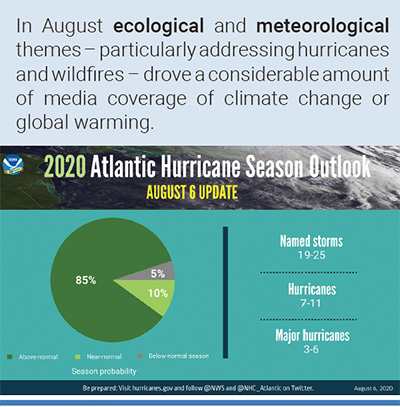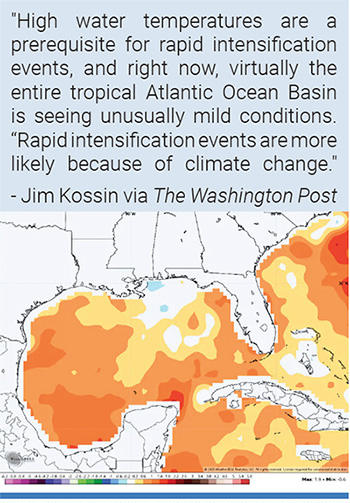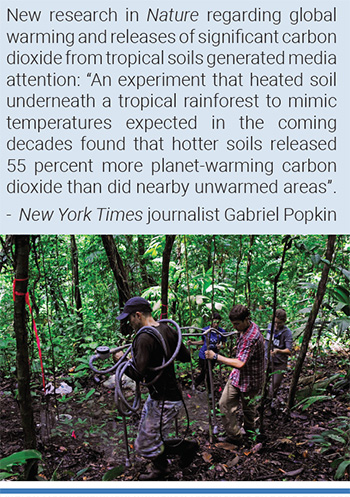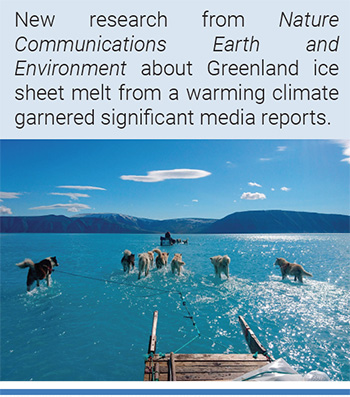Monthly Summaries
Issue 44, August 2020
[DOI]

Residents gathered at the Burton Complex, an event center in Lake Charles, Louisiana, for assistance with evacuation. Photo: William Widmer, New York Times.

August 2020 saw media coverage of climate change or global warming increase slightly from the previous month, up 3% across 120 sources in 54 countries in newspaper, radio and television accounts. However, coverage was 45% lower than August 2019 continuing a downward trend in media portrayals of climate change that the Media and Climate Change Observatory (MeCCO) has documented beginning February 2020 when the global COVID-19 pandemic began to dominate public attention. Figure 1 shows trends in newspaper media coverage at the global scale – organized into seven geographical regions around the world – from January 2004 through August 2020.

Figure 1. Newspaper media coverage of climate change or global warming in print sources in seven different regions around the world, from January 2004 through August 2020.
Regionally, coverage is down in Oceania (-57%), Africa (-52%), Europe (-47%), Latin America (-47%), North America (-37%), Asia (-36%), and the Middle East (-18%) from August 2019 levels of media attention to climate change or global warming. Yet coverage compared to the previous month of July is down less dramatically in Oceania (-1%), Africa (-6%), and Asia (-36%), while it remained steady in Europe and Latin America while increasing slightly in North America (+9%), and the Middle East (+4%). International wire services also increased slightly (+4%) from the previous month.
At the country level, of note several European countries have seen a drop in the amount of climate change media coverage from July to August 2020 with the fall most pronounced in Norway (-44%), as well as in Spain (-25%), Sweden (-15%), and Germany (-9%). Yet coverage was up in the United Kingdom (UK) (+10%), Russia (+10%), Australia (+12%), India (+13%), Denmark (+18%) and Canada (+26%). Coverage in the United States (US) wobbled as US newspaper coverage dropped a further 4% in August while US television coverage rose 62%.
This month - thanks to the Danish MeCCO team of Anne Gammelgaard Ballantyne and Lars Kjerulf Petersen – MeCCO has expanded monitoring to now track coverage in three newspapers in Denmark: Jyllandsposten, Politiken, and Berlingske Tidende. Notably, this systematic tracking now shows similar trends to those seen elsewhere in Europe and around the world over time, with a particular strong signal from the United Nations climate talks in December 2009 in the capital city of Copenhagen.

Figure 2. Danish newspaper media coverage of climate change (‘klimaforandringer’) or global warming (‘global opvarmning') in Jyllandsposten, Politiken, and Berlingske Tidende from January 2004 through August 2020.
The updated 2020 Atlantic hurricane season probability and numbers of named storms. Source: NOAA. |
Moving to the content of coverage, in August ecological and meteorological themes – particularly addressing hurricanes and wildfires – drove a considerable amount of media coverage of climate change or global warming. To begin, hurricane activity in the Atlantic and Caribbean Basin attracted many media stories that made links between their intensity and a changing climate. In early August, accounts of hurricane Isaias making landfall on the United States Carolina coast prompted connections between hurricanes and climate change.
For example, journalist Jeff Berardelli from CBS News reported, “The 2020 Atlantic hurricane season is racking up storms at breakneck speed. To date, the season is about two weeks ahead of record pace and it's only one third of the way through. On Wednesday, the news became more concerning as the research team at Colorado State University (CSU) — the standard bearer for seasonal forecasts — released the most dire forecast in their 37-year history. Labeling the 2020 hurricane season "extremely active," the team is now predicting 24 named storms, including 12 total hurricanes and 5 major hurricanes — each figure about double that of a normal season... The most obvious contributing factor for such an active season is water temperatures being near historic levels in the Tropical Atlantic, which can act like high-octane fuel to power hurricanes... The hotter-than-normal water is driven by the warm phase of a natural cycle called the Atlantic Multidecadal Oscillation (AMO) and boosted by human-caused climate change. Human warming has increased Tropical Atlantic sea surface temperatures by about two degrees Fahrenheit since 1901”.
To further illustrate, Associated Press journalist Seth Borenstein wrote, “Already smashing records, this year’s hyperactive Atlantic hurricane season is about to get even nastier, forecasters predict. In the coming months, they expect to run out of traditional hurricane names and see about twice as much storm activity as a normal year. The National Oceanic and Atmospheric Administration on Thursday upped its seasonal forecast, now predicting a far-above-average 19 to 25 named storms — seven to 11 of them to become hurricanes and three to six of those to become major hurricanes with winds of at least 111 mph (178 kph). That’s a few more storms than the agency’s May forecast. The agency increased the chance of an above average hurricane season from 60% to 85%... Sea surface temperatures in the eastern Atlantic are nearly 2 degrees (1 degree Celsius) warmer than normal. That not only provides more fuel for storms but changes air pressure and winds to make favorable conditions for storms to form and strengthen, he said. Emanuel of MIT pointed to an extra quiet Pacific storm season as another indicator for an active Atlantic. When the Pacific is quiet, the Atlantic tends to be much busier as they tend to balance out. Also, water temperatures near the equator in the Pacific are cooling, with a brewing La Nina, which is the flip side of El Nino. Research shows there are usually more Atlantic storms during a La Nina. Even though studies predict that a warmer world means generally stronger and wetter hurricanes, NOAA’s Bell and Emanuel said there are so many complicated factors in an individual season they can’t say either way whether man-made climate change is a factor in active years like 2020”.
Gulf of Mexico sea surface temperature anomalies in degrees Celsius. Virtually the entire Gulf is above average or well above average in terms of temperature. Source: Tropical Tidbits. |
Meanwhile, journalist Andrew Freedman from The Washington Post reported, “Driving the forecast is a series of factors that point to an unusually active season. These include widespread above-average sea surface temperatures in the tropical Atlantic Ocean, particularly in the main development region between West Africa and the Leeward Islands. In addition, there are above-average temperatures in the Caribbean Sea, and sea surface temperatures are also running well above average off the East Coast and in the Gulf of Mexico. The warm waters are the result, in part, of long-term, human-caused climate change, as well as natural climate cycles... Studies have shown that while warming sea and air temperatures are not leading to greater numbers of tropical cyclones, they are influencing their intensity in a detectable way”.
As a final example, New York Times reporter Henry Fountain shared comments from Dr. Gerry Bell from the National Oceanic and Atmospheric Administration, writing that Dr. Bell “said that it was too early to tell whether climate change was contributing to the activity this season. Hurricane activity in the Atlantic is greatly affected by two elements of the planet’s climate system — natural variations, over decades, in sea surface temperatures in the North Atlantic, and shorter-term temperature variations in the equatorial Pacific Ocean. The North Atlantic variability has led to increased overall hurricane activity since 1995. This year conditions in the equatorial Pacific — cooling sea-surface temperatures as the climate pattern known as La Niña starts to emerge — may be helping to increase activity as well by affecting wind patterns in the tropical Atlantic and Caribbean. But Dr. Bell said that whatever the contribution of climate change to this season’s activity, global warming affects the impacts of storms. Rising sea levels increase the danger of storm surges, he said, and warmer air temperatures generally make storms bring more rainfall”.
As coverage in the month of August continued, media attention to post-tropical storm Marco and tropical storm Laura coming on land in the US Gulf Coast region was pervasive. For instance, Washington Post journalists Matthew Cappucci and Andrew Freedman reported, “If Tropical Storm Laura does undergo rapid intensification, says Jim Kossin, a researcher at NOAA and the University of Wisconsin, “It’s very likely that climate change is playing some role in that.” He said the unusually warm waters of the gulf are tied in part to human-caused global warming, since the vast majority of the heat trapped in the atmosphere by greenhouse-gas emissions ends up in the oceans. High water temperatures are a prerequisite for rapid intensification events, and right now, virtually the entire tropical Atlantic Ocean Basin is seeing unusually mild conditions. “Rapid intensification events are more likely because of climate change,” he said in an interview”.
Andrew Nottingham, left, with fellow researchers on Barro Colorado Island in Panama, carrying a hand-made heating structure for their experiment. Photo: Geetha Iyer. |
Covering hurricane Laura in late August, Associated Press journalist Seth Borenstein reported, “A destructive storm is rising from warm waters. Again. America and the world are getting more frequent and bigger multibillion dollar tropical catastrophes like Hurricane Laura, which is menacing the U.S. Gulf Coast, because of a combination of increased coastal development, natural climate cycles, reductions in air pollution and man-made climate change, experts say”.
Furthermore, CNBC reporter Emma Newburger noted that “rising ocean temperatures driven by climate change are leading to more intense and destructive hurricanes. As hurricanes such as Laura strengthen more rapidly in warmer waters, states have less time to prepare storm mitigation and evacuate people from dangerous areas”. Also, Washington Post journalists Chris Mooney and Andrew Freedman reported that hurricane Laura “had rocketed into a high-end Category 4 storm, with wind speeds of nearly 145 mph, and was teetering toward Category 5 — the most dangerous. It was one of the fastest transformations on record in the Gulf of Mexico. Experts call the phenomenon “rapid intensification” and say it’s happening more frequently, thanks in part to warming ocean temperatures driven by climate change. The speed with which these storms morph can complicate both weather forecasting and emergency responses... Research shows that rapid intensification events are getting more common in the Atlantic hurricane region as the climate warms. In fact, some experts say, it is almost as if as the maximum “speed limit” for storms increases, the storms themselves, like drivers, are adjusting by speeding up”. Meanwhile, US National Public Radio journalist Rebecca Hersher noted, “Hurricane Laura's top wind speeds nearly doubled in just 24 hours as it approached the border between Texas and Louisiana. The wall of water it pushed in front of it grew until forecasters warned that it would produce "unsurvivable" storm surge. Laura's rapid intensification is one hallmark of climate change. As the Earth warms up, the water on the surface of the ocean gets hotter. Hot water is like a battery charger for hurricanes; it send energy and moisture into the storm as it forms and helps it grow more powerful and deadly”.
Not only did hurricane activity drive ecological and meteorological coverage in the US in August, news of wildfires and links to climate change also generated many media accounts. For example, wildfires first sparked by lightning strikes drove media attention. For example, journalist Nathan Rott from US National Public Radio reported, “California is facing a searing heat wave and a growing number of wildfires — challenges only projected to get worse with climate change”.
In August, there were also many media stories about scientific research and findings about aspects of climate change or global warming. Early in the month, new research in Nature regarding global warming and releases of significant carbon dioxide from tropical soils generated media attention. For example, New York Times journalist Gabriel Popkin reported, “Humble dirt could pack an unexpected climate punch, according to a new study published Wednesday in the journal Nature. An experiment that heated soil underneath a tropical rainforest to mimic temperatures expected in the coming decades found that hotter soils released 55 percent more planet-warming carbon dioxide than did nearby unwarmed areas. If the results apply throughout the tropics, much of the carbon stored underground could be released as the planet heats up”.
Dogs hauled a sled through meltwater on coastal sea ice in northwest Greenland in 2019. Photo: Steffen Olsen, Danmarks Meteorologiske Institut. |
In mid-August, new research from Nature Communications Earth and Environment about Greenland ice sheet melt from a warming climate garnered significant media reports. For example, CNN journalists Max Claypool and Brandon Miller reported, “Greenland's ice sheet has melted to a point of no return, and efforts to slow global warming will not stop it from disintegrating. That's according to a new study by researchers at Ohio State University... Greenland's ice sheet dumps more than 280 billion metric tons of melting ice into the ocean each year, making it the greatest single contributor to global sea level rise, according to Michalea King, the lead author of the study and researcher at Ohio State University. The ice loss has been so massive in recent years, she said, that it has caused a measurable change in the gravitational field over Greenland... Ice melting in Greenland contributes more than a millimeter rise to sea level every year, and that's likely to get worse. Sea levels are projected to rise by more than 3 feet by the end of the century, wiping away beaches and coastal properties. Coastal states like Florida, and low-lying island nations are particularly vulnerable. Just 3 feet of sea level rise could put large areas of coastline underwater. Forty percent of the US population resides in coastal areas that are vulnerable to sea level rise”.
As another example, BBC journalist Matt McGrath wrote, “Scientists say the loss of ice in Greenland lurched forward again last year, breaking the previous record by 15%. A new analysis says that the scale of the melt was "unprecedented" in records dating back to 1948. High pressure systems that became blocked over Greenland last Summer were the immediate cause of the huge losses. But the authors say ongoing emissions of carbon are pushing Greenland into an era of more extreme melting”. Journalist Robin McKie from The Guardian wrote, “"the level of ice loss is 'staggering'..."analysis indicates that sea level rises, triggered by melting glaciers and ice sheets, could reach a meter by end of the century”.
Political and economic media coverage of climate change or global warming was evident in August as well. For example, stories of pipeline pressures and conflicts in North America – relating to climate change pressures – shaped media narratives. To illustrate, journalist Sarah McFarlane from The Wall Street Journal wrote, “BP PLC cut its dividend for the first time in a decade and outlined plans to pivot away from oil and gas and invest more in low carbon energy—marking one of the most dramatic energy-transition plans among its oil major peers at a time of deep crisis for the industry. The British energy giant aims to increase its low-carbon investments to $5 billion a year by 2030, from around $500 million, at the same time as seeing its oil and gas production fall by 40% from 2019 levels”.
Meanwhile, Associated Press reporter Danica Kirka noted, “BP plc said Tuesday it plans to slash dividends as the global oil company prepares for declining sales of fossil fuels by boosting investment in alternative energy projects. London-based BP said it will increase spending on low-carbon technology, including renewable energy projects, 10-fold to $5 billion a year over the next decade. The company expects oil and gas production to drop by about 40% over the same period. To help finance the strategic shift, BP said it will cut dividends to 5.25 cents a share from 10.5 cents in the first quarter. That will help the company meet its previously announced goal of achieving net zero carbon emissions by 2050 or sooner. BP announced the shift as it reported a second-quarter operating loss of $6.68 billion as the COVID-19 pandemic cuts oil prices and demand for energy. The figure, which excludes one-time items and changes in the value of inventories, compares to an operating profit of $2.81 billion in the same period last year”.

Figure 3. Word cloud showing frequency of words invoked in media coverage of climate change or global warming in United States newspaper sources in August 2019 (left) and August 2020 (right) - from The Los Angeles Times, New York Times, USA Today, Wall Street Journal and Washington Post.
Finally, cultural themes continued to weave through many climate change or global warming stories in August. Several of these cultural stories also threaded through ecological and meteorological accounts described earlier. For example, in an early August New York Times article journalists Christopher Flavelle and Henry Fountain wrote, “A low-grade hurricane that is slowly scraping along the East Coast. A wildfire in California that has led to evacuation orders for 8,000 people. And in both places, as well as everywhere between, a pandemic that keeps worsening. The daily morning briefing from the Federal Emergency Management Agency, usually a dry document full of acronyms and statistics, has begun to resemble the setup for a disaster movie. But rather than a freak occurrence, experts say that the pair of hazards bracketing the country this week offers a preview of life under climate change: a relentless grind of overlapping disasters, major or minor. The coronavirus pandemic has further exposed flaws in the nation’s defenses, including weak construction standards in vulnerable areas, underfunded government agencies, and racial and income disparities that put some communities at greater risk. Experts argue that the country must fundamentally rethink how it prepares for similar disasters as the effects of global warming accelerate”.
Ongoing media attention to Greta Thunberg and the Fridays for Future School Strikes for climate action campaign continued in August as well. For example, Agence-France Presse and The Guardian reported, “Swedish environmental activist Greta Thunberg has returned to school after a year off campaigning to curb climate change... Thunberg did not say in which city or school she would be continuing her studies. Since her last school year finished in June 2019, the teenager’s travels around the world meant that she ended up doing lessons remotely. Rather than head into the final years of secondary school, she travelled across the Atlantic by sailing boat – hoping to highlight the carbon emissions of flying”.
Thanks for your ongoing interest in the work we do through the Media and Climate Change Observatory (MeCCO). We remain committed to our work monitoring media coverage of these intersecting dimensions and themes associated with climate change in this year 2020. To help us continue this work, please give what you can to https://giving.cu.edu/fund/media-and-climate-change-observatory-mecco.





